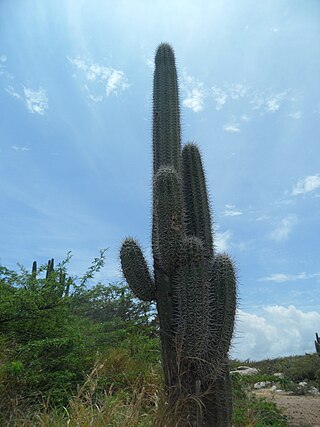Top Qs
Timeline
Chat
Perspective
Stenocereus griseus
Species of cactus From Wikipedia, the free encyclopedia
Remove ads
Stenocereus griseus, also known as the Mexican organ pipe, dagger cactus, pitaya, and pitayo de mayo, is a species of cactus.[3]
Remove ads
Description
Stenocereus griseus is a tree-shaped cactus that grows to 6-9 meters tall with a clear trunk and upright green stems, about 9-12 centimeters in diameter, with six to ten ribs below the areoles.[2] It bears one to three central spines up to 1.5 centimeters long, the longest of which reaches 4 centimeters, and six to eleven marginal spines measuring 6-10 millimeters long.
This species produces white, funnel-shaped flowers that bloom at night and last until midday, with bent-back flower bracts. The flowers are about 10 centimeters long. Its spherical to elongated fruits are white, yellowish green, to red or dark purple, up to 5 centimeters in diameter, and covered with thorns that shed when ripe. The flesh is red.[4]
- Habit
- Flower
- Branch
- spine
- seedling
- Stenocereus griseus fence in Santa Cruz Aruba
Remove ads
Distribution
This species is found in Mexico in Oaxaca and Veracruz,[2] coastal Venezuela, Guajira Peninsula of Colombia and the ABC islands of the Dutch Caribbean.[5] It is found in scrub-lands.[1] Observations of this species have also been reported in the dry scrub-lands at the base of the Eastern Cordillera of the Colombian Andes. However it has not been collected in this region.[6] In the Caribbean islands of Aruba, Curaçao and Bonaire, this cactus blooms and fruits profusely during the dry season. It is a critical resource for bats, birds and other animals.[1]
- Stenocereus griseus habitat in Arashi Bay Coast, Noord Aruba
- Stenocereus Griseus growing in habitat in Noord Aruba
Remove ads
Human uses
Its fruit is edible to humans and is considered good tasting. It is planted as an ornamental and as a living fence in warm regions.[1][7] When used as a fence, it can be impervious to animals due to its spiny nature.[7]
Taxonomy
First described as Cereus griseus in 1812 by Adrian Hardy Haworth, the species was later placed in the genus Stenocereus by Franz Buxbaum in 1961.[8] The specific epithet "griseus" derives from Latin, meaning 'gray,' in reference to the thorns of the species. The species is found in CITES Appendix II as a species of Least Concern. Its population is considered stable.[1]
References
External links
Wikiwand - on
Seamless Wikipedia browsing. On steroids.
Remove ads










